

Don't miss our related program on Feb. 20.
“Travel is fatal to prejudice, bigotry, and narrow-mindedness, and many of our people need it sorely on these accounts. Broad, wholesome, charitable views of men and things cannot be acquired by vegetating in one little corner of the earth all one's lifetime.” ~
I first learned about the existence of "The Negro Motorist Green Book" from Ann Thomas, when I interviewed her in 2012 for the second volume of The Wheeling Family. Both sides of Ann's family were originally from North Carolina before joining the Great Migration and moving north for better treatment and increased opportunity. Ann’s Aunt Esther May (her mother’s sister) and Uncle Maxton "Mac" Singletary were among the first of her family to choose Wheeling as their new home. They migrated from North Carolina and opened the New Dixie Restaurant, aka "Singletary's," in an old Victorian residence on Chapline Street in the middle of what was, at the time, an established African American neighborhood.
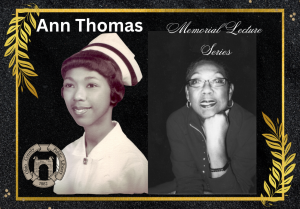 The family lived upstairs, and earned extra income by renting rooms to boarders. “Because of segregation,” Ann said, “there was an economy in Wheeling that catered to the African American community.” There was a robust black community on Chapline Street where the restaurant was located while Ann was growing up, primarily concentrated in the 1100 and 1200 blocks. Many of the businesses were Black-owned, but most of Wheeling remained segregated during Ann’s childhood – “Jim Crow laws” still forcibly separating blacks and whites in most public facilities. Thus, the Black neighborhood on Chapline Street north of 12th Street evolved into one of the nation's thousands of "Little Harlems," a reference (see Alvin Hall's Driving the Green Book below) to the New York neighborhood that became the standard for Black culture during the Jim Crow era. It became, in effect, a second Wheeling, existing side-by side with White Wheeling, but with virtually no interaction. As Ann explained it, when the trains were still running in Wheeling, African American men who worked on the trains often needed a place to stay during an overnight layover. In segregated Wheeling, laws or policies prevented them from staying in the White only hotels. Even when famous Black people, like heavyweight champion Joe Louis, visited Wheeling, they had no choice but to stay in the African American neighborhood. In a 1936 speech delivered for the Blue Triangle Branch of the YWCA's "Race Relations Day," over radio station WWVA, Wheeling's only Black attorney at the time, Harry H. Jones, provided some detail for the economy of "Wheeling's Little Harlem," the Chapline Street neighborhood:
The family lived upstairs, and earned extra income by renting rooms to boarders. “Because of segregation,” Ann said, “there was an economy in Wheeling that catered to the African American community.” There was a robust black community on Chapline Street where the restaurant was located while Ann was growing up, primarily concentrated in the 1100 and 1200 blocks. Many of the businesses were Black-owned, but most of Wheeling remained segregated during Ann’s childhood – “Jim Crow laws” still forcibly separating blacks and whites in most public facilities. Thus, the Black neighborhood on Chapline Street north of 12th Street evolved into one of the nation's thousands of "Little Harlems," a reference (see Alvin Hall's Driving the Green Book below) to the New York neighborhood that became the standard for Black culture during the Jim Crow era. It became, in effect, a second Wheeling, existing side-by side with White Wheeling, but with virtually no interaction. As Ann explained it, when the trains were still running in Wheeling, African American men who worked on the trains often needed a place to stay during an overnight layover. In segregated Wheeling, laws or policies prevented them from staying in the White only hotels. Even when famous Black people, like heavyweight champion Joe Louis, visited Wheeling, they had no choice but to stay in the African American neighborhood. In a 1936 speech delivered for the Blue Triangle Branch of the YWCA's "Race Relations Day," over radio station WWVA, Wheeling's only Black attorney at the time, Harry H. Jones, provided some detail for the economy of "Wheeling's Little Harlem," the Chapline Street neighborhood:
"A brief survey of our local colored population shows: that the group has six churches of three denominations; that it owns real estate worth about $500,000; that it manages one fraternal corporation worth nearly $130,000; one drug store, one tailor shop, two restaurants, two billiard parlors, and two beauty shops. In the professions, business, trades and personal service, the group is represented by: four physicians; two dentists; twelve clergymen; one lawyer; twenty-two school teachers; one chiropodist; two undertakers; two social workers; three tailors; four beauty parlor operators; two master hat cleaners, and a large number employed as cooks, maids, waiters, messengers, porters, bootblacks, janitors, elevator operators, chauffeurs, and barbers."
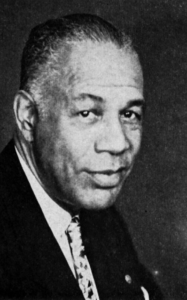 Victor Hugo Green.
Victor Hugo Green.
But for those who weren't from Wheeling -- train workers or Black travelers, for example -- how were they to know about the neighborhood and the safe places it offered? It was in answer to this question that Ann first mentioned the Green Book, the first several editions of which lists the Singletarys’ establishment as the only restaurant option in Wheeling. Conceived and published (from 1936 to 1967) by a mailman named Victor Hugo Green with his wife Alma, the publication was designed to help black travelers locate, “boarding houses, restaurants, beauty shops, barber shops and various other services…” and to help them “avoid as many difficulties and embarrassments as possible." As the Library of Congress put it:
"The Green Book became 'the Bible of black travel' during the era of Jim Crow laws, when open and often legally prescribed discrimination against African Americans and other non-whites was widespread. Green wrote this guide to identify services and places relatively friendly to African-Americans so they could find lodgings, businesses, and gas stations that would serve them along the road. It was little known outside the African-American community."
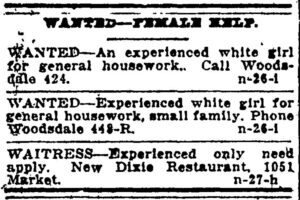 Tellingly, above this early newspaper ad for a waitress at the New Dixie are two ads for a "white girl" to do housework.
Tellingly, above this early newspaper ad for a waitress at the New Dixie are two ads for a "white girl" to do housework.
Ann’s aunt and uncle needed help with the restaurant, so, when Ann (born 1938) was just six months old, her mother, Laura, who grew up on a North Carolina tobacco and cotton farm with 13 siblings, moved with her daughter to Wheeling. Ann's aunt and mother ran the restaurant while her Uncle Mac worked as a mailman in Bridgeport, Ohio. The arrangement was a typical one for segregated neighborhoods, where female entrepreneurship was essential to these new economies. Jim Crow laws forbade African Americans from sitting down and eating at any of the local restaurants, unless they were black owned. In addition, most of Wheeling’s many theaters were white only. “There was a black movie theater called the ‘Fedo’ located in the African American Pythian Building," Ann recalled, "which also offered a pool hall and barbershop in the basement area. There was a drugstore—Doc White’s Pharmacy [two doors down from the movie theater]. Doc’s store had a soda fountain in the back. The front was more of a drugstore or general store. In the basement of the drugstore was a jukebox, old wire tables and chairs, and Friday evenings or on Saturdays, that was kind of a social place to meet." Doc's pharmacy would also be listed in the Green Book.
"Afoot and light-hearted I take to the open road, Healthy, free, the world before me, The long brown path before me leading wherever I choose." -Walt Whitman, "Song of the Open Road"
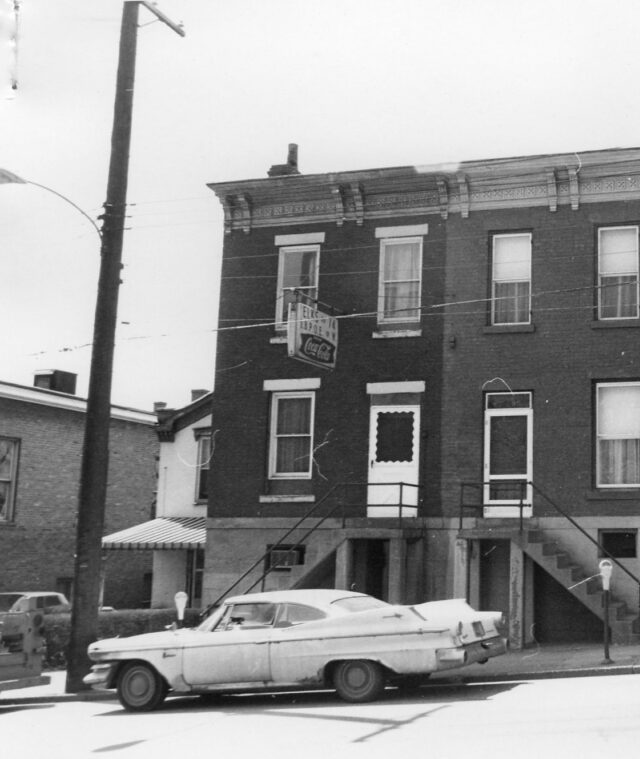 The "Black Elks Club" on Chapline St. appeared in the 1939 Green Book. -Urban Renewal photos.
The "Black Elks Club" on Chapline St. appeared in the 1939 Green Book. -Urban Renewal photos.
Wheeling establishments first appeared in the 1939 edition of the Green Book. These included the Verse Hotel at 1042 Market Street; the aforementioned Singletary Restaurant at 1043 Chapline; The American Legion at 1516 Main and Elks Club at 1010 Chapline (both listed under "Night Clubs"); and two beauty parlors Miss Hall on 11th St. and Miss Taylor on Chapline. Another beauty parlor, "Mode-Craft," was listed from 1950-54 at 1028 1/2 Chapline.
Left-An ad for the Gre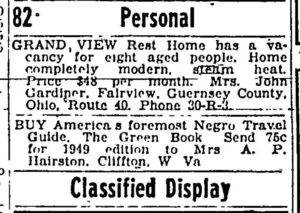 en Book in the February 20, 1949 News-Register.
en Book in the February 20, 1949 News-Register.
Also listed were four addresses under "Tourist Homes" -- more or less rooms for rent or boarding houses. One of these, at 114 12th Street, belonged to Mrs. W. (Elizabeth) Turner, widow of Wheeling's first African -American police officer, William Turner, who died in 1928. Mrs. Turner's tourist home would remain in the Green Book until 1960. Other such homes were owned by Mrs. C. Early (132 12th), Mrs. R. Williams (1007 Chapline), and Mrs. J.T. Hughes (1021 Eoff St.). These businesses also verify the importance of female entrepreneurship in segregated Black neighborhoods.
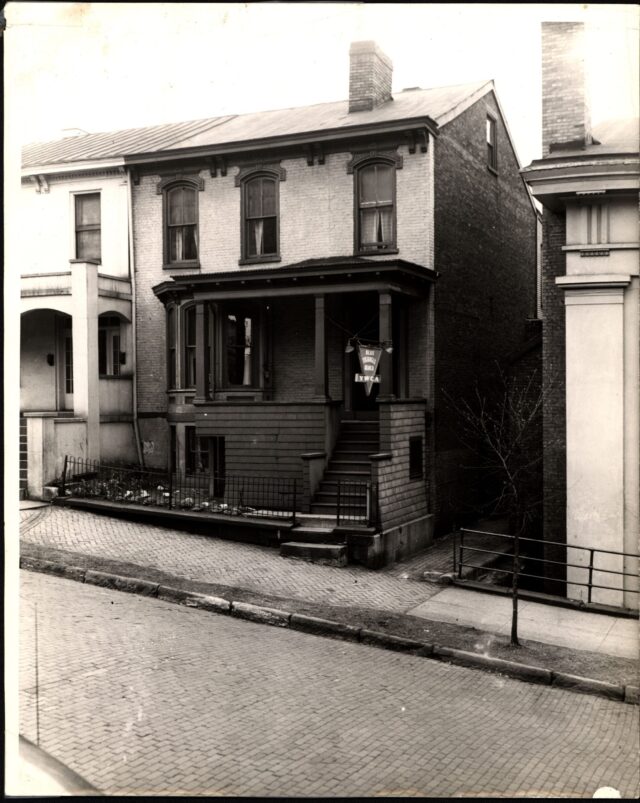 The Blue Triangle house on 12th. This was still standing when Ann showed it to me in 2012. -OCPL Archives
The Blue Triangle house on 12th. This was still standing when Ann showed it to me in 2012. -OCPL Archives
The Verse Hotel disappeared from the 1941 edition, and the Green Book itself halted publication during the Second World War, resuming in 1946. The Blue Triangle (segregated) Branch of the Y.W.C.A. was first listed in the 1949 Green Book under "Lodging," which replaced "Tourist Homes" as a category. Located on 12th Street, the Blue Triangle, in addition to teaching life skills to African American girls, was highly active in trying to improve race relations in Wheeling. Its archives, now a part of the collections of the Ohio County Public Library, are an invaluable resource. 1949 was also the last year for the Singletary Restaurant to be listed. It was replaced by the "Blue Goose" at 1035 Chapline in 1950. Also making its first appearance under "Drug Stores" in the 1950 edition was Doc White's "North Side Pharmacy." So remained the Wheeling listings until 1956, when only the Blue Triangle, Blue Goose, and Mrs. Turner's place were still listed. The Blue Triangle dropped out in 1957, and by 1958, only Mrs. Turner remained. By 1961, there were no listings for Wheeling, while Moundsville still offered lodgings at Mrs. Blanche Campbell's place at 1206 4th Street. As the Library of Congress put it, "Shortly after passage of the Civil Rights Act of 1964, which outlawed the types of racial discrimination that made the Green Book necessary, publication ceased and it fell into obscurity." Ironically, this progressive and necessary step forward also spelled the end for many of the Black-owned businesses of Chapline Street.
View the new book display featuring books related to the Green Book, now at your library.
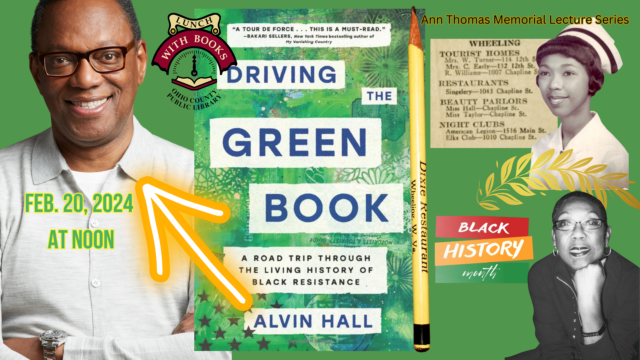
Don't miss the 2024 Ann Thomas Memorial Lecture at Lunch With Books at the Ohio County Public Library on February 20 at noon. Our guest will be Alvin Hall, an internationally renowned financial educator, award-winning television and radio broadcaster, artist, and bestselling author. In the summer of 2019, Mr. Hall, with companions Janée Woods Weber and Oluwakemi (Kemi) Aladesuyi, hit the road for a 12-day, 2,000-mile trip from Detroit to New Orleans. The route was based on information gathered from the historic travel guide, The "Negro Motorist Green Book." The people he interviewed shared powerful stories and memories of that time that became the center of the award-winning podcast and book, "Driving the Green Book," Hall's subject for Lunch With Books.
© Copyright 2026 Ohio County Public Library. All Rights Reserved. Website design by TSG. Powered by SmartSite.biz.